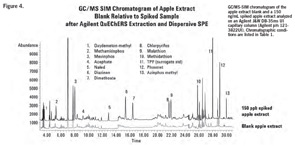The GC/MS-SIM analysis was able to detect down to the 15-20 ng/mL range for most of the pesticides. A higher SIM signal is necessary to quantify the more volatile pesticides below the 30 ng/mL range, mainly because of matrix interferences. Because flame photometric detection in phosphorus mode is selective only for analytes containing phosphorus, it is able to detect low levels of OP pesticides in complex matrices without the matrix interferences. The FPD was able to detect the OP pesticides down to 15 ng/mL, with the exception of naled, which could only be detected at higher levels (>25 ng/mL). Naled can undergo debromination, which can affect detection, especially at trace levels. The detection levels for the targeted OP pesticides were well below the U.S. maximum residue levels in an apple matrix, except in the case of chlorpyrifos, which has an MRL of 10 ppb for apples and grapes.11 Analysis by GC/FPD without flow splitting offers increased sensitivity to monitor the lower levels of detection needed for chlorpyrifos.

The extraction process, using the QuEChERS method, was effective in retaining the OP pesticides in the spiked apple sample and providing sufficient cleanup of the sample matrix for GC/MS analysis. Figure 4 shows the OP pesticide mix spiked into an apple matrix sample. The matrix was prepared using a QuEChERS sample preparation approach that included extraction/partitioning and dispersive SPE. A GC/MS-SIM blank matrix trace is shown below the analyte trace to indicate the level of potential matrix interference with the analytes of interest. Peak shapes for the OP pesticides are still quite sharp and well resolved, indicating excellent performance on the DB-35ms UI column in a fruit matrix.
Recoveries were determined by GC/MS-SIM at the 150, 300, and 750 ng/mL levels, and 50, 100, and 250 ng/mL using the FPD in phosphorus mode. The recoveries for most of the pesticides were greater than 75%, with average RSDs below 10%. Recoveries for the individual OP pesticides are listed in Table 4. Lower recoveries were noted for the more polar pesticides: oxydemeton-methyl, methamidophos, and acephate. One possible explanation is that these polar, highly water-soluble pesticides may have been partially lost through incomplete partitioning into the aqueous layer during the extraction step.12
Conclusions
This application note successfully shows a quick and efficient analytical method to monitor low and trace level OP pesticide residue in apple samples. Splitting the column effluent to an MSD and FPD facilitated selectivity, identification, and confirmation of OP pesticides from a single injection, thereby increasing laboratory productivity. Using GC/MS in full scan mode enabled identification of specific pesticides, while SIM mode offered selectivity and sensitivity for quantitation of the pesticides at trace levels. Confirmation and further specificity were achieved by FPD in phosphorus mode. FPD detection was effective at minimizing matrix interferences, enabling lower detection.
The Agilent QuEChERS method for general fruits and vegetables provided enough sample cleanup to minimize matrix interferences while still maintaining low-level analyte detection. The simple QuEChERS extraction method allows for faster sample prep, facilitating higher sample throughput. Residual sample matrix carryover is removed through use of backflush, which eliminates the need for a bakeout cycle, significantly reducing analytical run times.

The Agilent J&W DB-35ms UI capillary column resolves the targeted OP pesticides and provides excellent peak shapes for the polar pesticides, allowing for more reliable quantitation at low levels. Detection levels for the OP pesticides were at or below the U.S. maximum residue levels for various fruits. Matrix-matched calibration standards yielded regression coefficients r2 ≥ 0.992, and recoveries from fortification studies were greater than 75% with an average RSD <10% for both GC/MS-SIM and FPD, further demonstrating the effectiveness of using an Agilent J&W DB-35ms UI column for residual pesticide determination.
ACCESS THE FULL VERSION OF THIS ARTICLE
To view this article and gain unlimited access to premium content on the FQ&S website, register for your FREE account. Build your profile and create a personalized experience today! Sign up is easy!
GET STARTED
Already have an account? LOGIN
